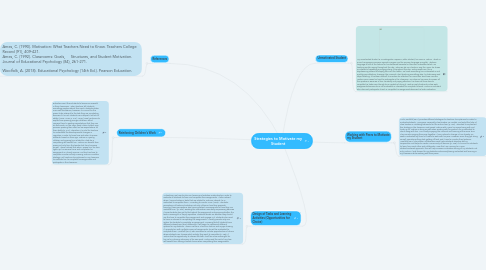Strategies to Motivate my Student
by Liliana Pantoja

1. Design of Tasks and Learning Activities (Opportunities for Choice)
1.1. As teachers, we have to plan our lessons and activities meticulously in order to motivate all students to learn and complete their assignments. I have noticed when I have activities or tasks that are related to Joshua's interest, he is motivated to complete them. According to Carole Ames (1992), "Students' perceptions of tasks and activities not only influence how they approach learning; these perceptions also have important consequences for how they use available time" (p. 263). Reading this information was really empowering because I know students also get to think about the assignment and perceive whether the task is meaningful or simply repetitive. Students decide on whether they should use the time to complete their assignment and engage in it. Students also need to have an interest in completing the assignments. I usually provide only one option for students to complete an assignment. Knowing that all students have different interests and learn differently, I will begin to implement different options for my students. I know Joshua is a hand-on learner and enjoys drawing. If I provide him with multiple means of assignments, he will be motivated to complete them. Woolfolk (2017) also mentions to include opportunities of choice where students can choose which activity they want to complete (p. 480). If Joshua has the opportunity to choose the task, it will be more meaningful for him as he is having autonomy of his own work. Joshua and the rest of my class will benefit from having a board choice when completing their assignments.
2. References
2.1. Ames, C. (1990). Motivation: What Teachers Need to Know. Teachers College Record (91), 409-421. Ames, C. (1992). Classrooms: Goals, Structures, and Student Motivation. Journal of Educational Psychology (84), 261-271. Woolfolk, A. (2018). Educational Psychology (14th Ed.). Pearson Education.
3. Reinforcing Children's Work
3.1. Educators want their students to become successful in their classrooms. When teachers tell students something positive about their work, students obtain more self-confidence; however, it is crucial for the praise to be relevant to the task they are completing because if it is not, students can interpret it as lack of ability (Ames, 1990, p. 416). Ames (1990) continues to explain how praising younger children's effort conveys them to positive expectations that they can do their work; on the other hand, older children may perceive praising their effort as low expectations for their ability (p. 416). Therefore, it is vital for teachers to understand the developmental changes in cognition in order to know how and when to praise students’ based on their age. Joshua is a young children and praising him related to a task he is completing will benefit him. Joshua can benefit from praise not only from the teacher but from his peers as well. I have noticed that when I praise him, his face lights up, he remains focus and completes his assignment in a timely manner. He then has time to complete a center activity. Praising Joshua is another strategy I will continue to implement in my classroom to motivate him to complete his assignments and participate in the classroom.
4. Unmotivated Student
4.1. My unmotivated student is a Kindergarten Hispanic-White student; his name is Joshua. I teach in a Dual Language Immersion Spanish Program and his primary language is English. I believe language is one of the factors for his disinterest because he does not understand what I am teaching and/or saying throughout the day. When we do our chants or sing the ABCs, he shows no interest of repeating or singing along. Throughout the day, Joshua seems as if he is daydreaming instead of staying focus on the lesson. He hears something he is interested in and quickly pays attention; however, the moment I start teaching something else, he looks away and stops listening. It has been difficult to maintain his attention for more than two-three minutes. Joshua never raises his hand to participate in the classroom. He relies on his peers to answer all the questions. Because of him constantly not paying attention, he does not know how to complete his tasks even though he is capable of doing it. Joshua rarely finishes his class work assignments because he is not motivated or interested to complete his work. Joshua is a student who does not participate, chant, or complete his assignments because he lacks motivation.
5. Working with Peers to Motivate my Student
5.1. Anita Woolfolk (2017) provides different strategies for teachers to implement in order to motivate students; "use peers, especially class leaders, as models, and enlist the help of class leaders in modeling behaviors for the entire class"(p. 420). I decided to implement this strategy in the classroom and paired Joshua with a peer he enjoys being with and looks up to. Joshua is doing so well when working with his partner. He is motivated to chant along with him. He is really enjoying the moment and learning at the same time. They are also singing the songs together. I have noticed a change in him already. He seems motivated any time he is able to work with his peer. However, since they get along so well, sometimes they start getting off task, and I have to monitor their behavior. Woolfolk (2017) also states, collaborative work helps students develop skills in cooperation and helps to create a community of learners (p. 438). It is crucial for students to learn from each other and collaborate. Now that I am moving to a more student-centered approach, this will help increase motivation among all my students, not only Joshua. I look forward to my students continuously being motivated and learning in my classroom while working with their peers.


